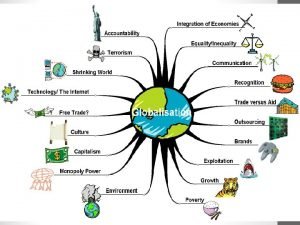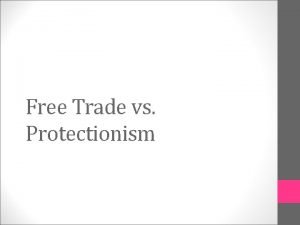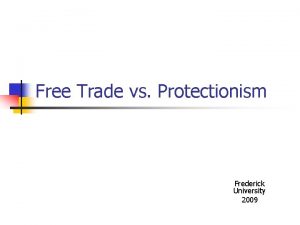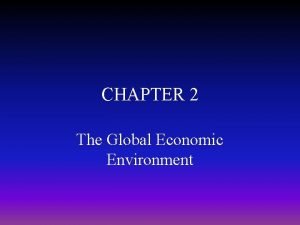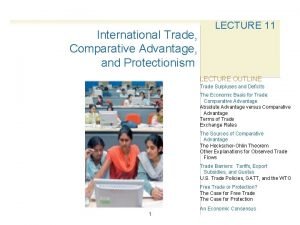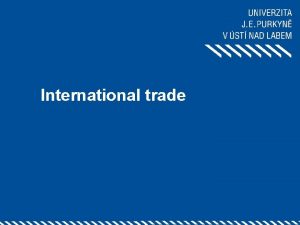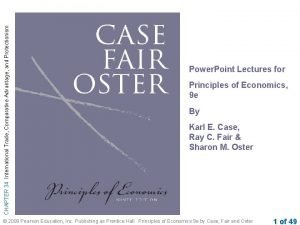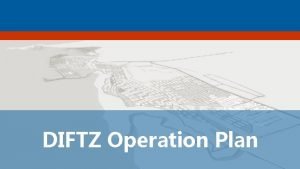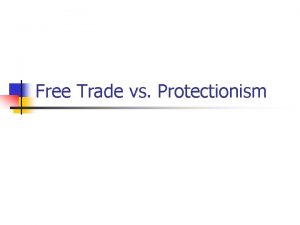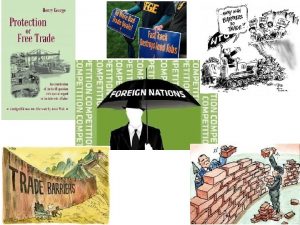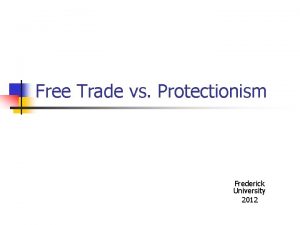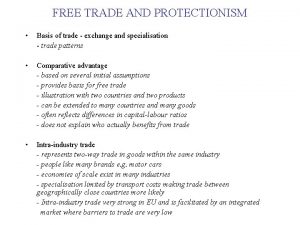International trade Protectionism Free Trade and the Role









- Slides: 9

International trade Protectionism, Free Trade and the Role of GATT and the WTO. 1

Protection Developed Countries have used trade intervention policies with the following intentions n n n n To preserve or encourage mature industries, such as steel or ship building To promote sectors strategic for growth such as high technology industries (infant industry argument) to protect sectors important for national defence and security To correct persistent trade imbalances To protect employment of labour To offset the ‘unfair’ trade actions of other countries To operate profit maximising strategic trade polices 2

Trade Policy Instruments Numerous Instruments w Tariffs on Imports w Quantitative Restrictions w Subsidies w Technical barriers w Administration barriers w Grants loans for industrial development w Preferential taxation for firms w Low interest rate loans 3

Trade Liberalisation w GATT (1947 -1994) w World Trade Organisation (WTO: 1995): 143 members w WTO philosophy is based in five principles; n n n Trade without discrimination between trading partners (MFN ) or between national and foreign goods and services (NTP) Freer Trade through negotiation Predictable policies Open and Fair Competition Special Provisions for developing countries 4

Uruguay Round w 1986 -94; eighth round of GATT negotiations. Resulted in creation of WTO. w The implementation of the Uruguay Round gained an estimated $170 bn per year by the end of 2002 (about 0. 6% of world GDP) w The largest welfare gains went to the EU, followed by the US and Japan (measured in bns of dollars); As a % of GDP, the largest gains went to Thailand, Korea, and the Phillipines. Sub-Saharan Africa suffered a slight loss in welfare 5

WTO w Three goals n Promote trade flows n Reduce remaining trade barriers n Establish impartial procedures for resolving disputes among members w Main Differences Between GATT and the WTO n GATT was a set of rules for conducting international trade with no solid institutional base. The WTO is an intergovernmental organisation n GATT was a provisional agreement. WTO and its agreements are manadatory and permanent n The GATT dealt with trade in goods. WTO covers trade in services (GATS), Trade related aspects of Intellectual Propery Rights (TRIPS) and Trade Related Investment Measured (TRIMS) as well as goods n Faster and more automatic dispute settlement system than under the 6 GATT

Outstanding Problems w Some sectors not included (eg films & TV); protection in agriculture remains high; Antidumping agreements not restrictive enough. w Trade problems in developing countries not addressed w No specific provisions for transition economies w Problem of trading blocs (EU, NAFTA and Asian Bloc) w Labour and Environmental Standards need to be addressed. 7

From Seattle to Doha w Failure of WTO conference in Seattle in December 1999 because n n n Developing countries opposed to putting labour and environmental standards on the agenda which developed countries wanted EU and Japan objected to complete liberalisation in Agriculture US objected to discussion on competition and investment policies that the EU wanted All this in the midst of large demonstrations against the WTO and globalisation 8

Doha (2001) w Doha: agreement to launch a new set of trade talks from January, 2002 -2005. w Discussions designed to open markets on agricultural and manufactured goods. In addition the links between trade and environment will be addressed. w How will this impact on the World Economic System? n n Developing countries playing a more active role EU versus US: Emergence of the EU as the major driving force on world trade 9
 Free trade vs protectionism
Free trade vs protectionism Free trade vs protectionism
Free trade vs protectionism Protectionism in trade
Protectionism in trade Protectionism pros and cons
Protectionism pros and cons Protectionism definition economics
Protectionism definition economics Benefits of protectionism economics
Benefits of protectionism economics Advantages of protectionism
Advantages of protectionism Fair trade not free trade
Fair trade not free trade Djibouti international free trade zone
Djibouti international free trade zone What is web role and worker role in azure
What is web role and worker role in azure
